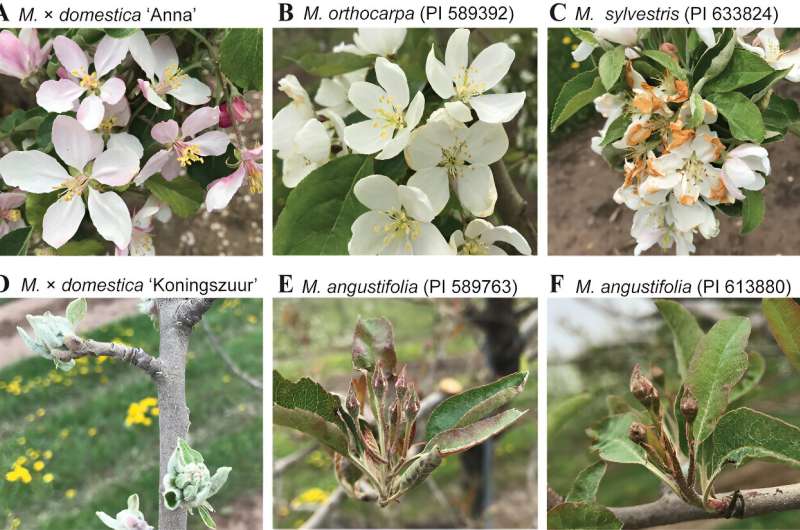This article has been reviewed according to Science X's editorial process and policies. Editors have highlighted the following attributes while ensuring the content's credibility:
fact-checked
peer-reviewed publication
trusted source
proofread
Bloom times vary in Malus species due to floral development rate

The domesticated apple (Malus ×domestica) is an economically valuable crop and an important source of nutrients and calories throughout temperate regions of the world. Fruit production is directly influenced by bloom time, which is a highly heritable trait greatly affected by the way a genotype perceives its environment. Because of climate change, fruit trees are becoming more susceptible to crop loss.
First, early spring freezes may damage developing flower buds and reduce crop yield. These erratic weather events are increasing. Second, climate change has affected chilling accumulation during winter, which disrupts the flower development and synchronicity of bloom. Third, apple flowers are largely self-incompatible, thus requiring growers to select cultivars that bloom synchronously to ensure adequate cross-pollination.
Finally, environmental conditions that cause later bloom may result in apple trees being more prone to infection by Erwinia amylovora, the bacterial pathogen that causes fire blight. These production considerations underscore the importance of studying flower development in Malus.
In response to challenges caused by climate change, apple breeding programs must quickly develop more resilient cultivars. One strategy is to breed for various bloom times. Members of the genus Malus, including domesticated apple, wild species, and hybrids, exhibit striking variations in the bloom date. Although bloom time is strongly influenced by chilling requirements, other aspects of floral development in Malus and their contributions to bloom time are less known.
A new study has aimed to investigate potential connections between predormancy flower development and final bloom time in Malus species. Researchers performed a phenological analysis of flower development in wild and domesticated apple with extreme differences in bloom time over the course of one developmental season. They tracked histological changes in the floral apex of representatives of three early-blooming Malus genotypes (M. ×domestica "Anna" PI 280400, M. orthocarpa PI 589392, M. sylvestris PI 633824) and three late-blooming genotypes (M. angustifolia PI 589763, M. angustifolia PI 613880, M. ×domestica "Koningszuur" PI 188517).
The work is published in the Journal of the American Society for Horticultural Science.
The study documented their floral meristem progression and organ development and expanded on current staging systems for apple flower development to describe the changes observed. The developmental trajectories of each genotype did not group according to bloom category, and the team observed variations in the floral development stage at the time of dormancy onset.
This research was a preliminary investigation of whether timing of floral initiation and organogenesis in Malus correlate with final bloom time. The researchers documented flower development in early-blooming and late-blooming Malus species over the course of the 2018–19 season. Both genotypic differences in rates of floral bud development and differences in developmental stages before dormancy were identified. Furthermore, the rate of floral development did not strictly correlate with early and late bloom categories.
Although this study would be stronger if the team had sampled a larger number of buds or extended collections over multiple seasons, the results and conclusions are reasonable because floral development was fairly synchronized within the genotypes at each time point. The results provide valuable comparative phenological data from wild and domesticated apple accessions. This research will inform future studies of flowering in fruit trees and may influence breeding strategies targeting bloom time.
More information: Charity Z. Goeckeritz et al, Malus Species with Diverse Bloom Times Exhibit Variable Rates of Floral Development, Journal of the American Society for Horticultural Science (2023). DOI: 10.21273/JASHS05236-22
Journal information: Journal of the American Society for Horticultural Science
Provided by American Society for Horticultural Science




















